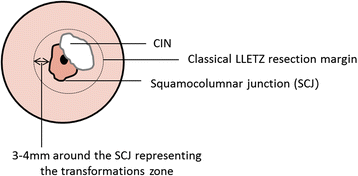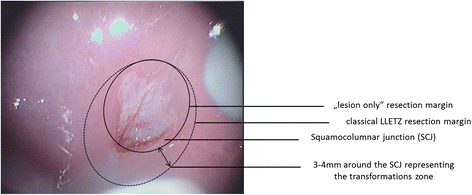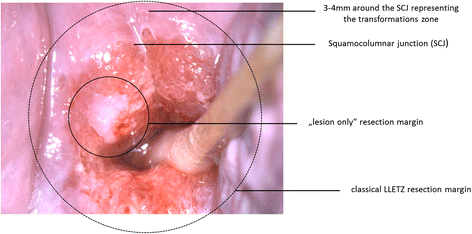Comparison of two surgical methods for the treatment of CIN: classical LLETZ (large-loop excision of the transformation zone) versus isolated resection of the colposcopic apparent lesion - study protocol for a randomized controlled trial
- PMID: 26002493
- PMCID: PMC4443515
- DOI: 10.1186/s13063-015-0736-8
Comparison of two surgical methods for the treatment of CIN: classical LLETZ (large-loop excision of the transformation zone) versus isolated resection of the colposcopic apparent lesion - study protocol for a randomized controlled trial
Abstract
Background: In compliance with national and international guidelines, non-pregnant women with cervical intraepithelial neoplasia grade 3 should be treated by cervical conization. According to the definition of the large loop excision of the transformation zone (LLETZ) operation, the lesion needs to be resected, including the transformation zone. It is well known from the literature that the cone size directly correlates with the risk of preterm delivery in the course of a future pregnancy. Thus, it would be highly desirable to keep the cone dimension as small as possible while maintaining the same level of oncological safety.
Methods/design: The aim of this study is to analyze whether resection of the lesion only, without additional excision of the transformation zone, is equally as effective as the classical LLETZ operation regarding oncological outcome. We are performing this prospective, patient-blinded multicenter trial by randomly assigning women who need to undergo a LLETZ operation for cervical intraepithelial neoplasia grade 3 to either of the following two groups at a ratio of 1:1: (1) additional resection of the transformation zone or (2) resection of the lesion only. To evaluate equal oncological outcome, we are performing human papillomavirus (HPV) tests 6 and 12 months postoperatively. The study is designed to consider the lesion-only operation as oncologically not inferior if the rate of HPV high-risk test results is not higher than 5 % compared with the HPV high-risk rate of women undergoing the classical LLETZ operation.
Discussion: In case that non-inferiority of the "lesion-only" method can be demonstrated, this operation should eventually become standard treatment for all women at childbearing age due to the reduction in risk of preterm delivery.
Trial registration: German Clinical Trials Register (DRKS) Identifier: DRKS00006169 . Date of registration: 30 July 2014.
Figures




References
-
- National Cancer Institute, National Institutes of Health. Cervical cancer treatment – for health professionals (PDQ). http://www.cancer.gov/types/cervical/hp/cervical-treatment-pdq#section/all. Accessed 15 May 2015.
-
- Trottier H, Franco EL. The epidemiology of genital human papillomavirus infection. Vaccine. 2006;24(Suppl 1):S1–15. - PubMed
-
- Workowski KA, Berman SM. Sexually transmitted diseases treatment guidelines, 2006. MMWR Recomm Rep. 2006;55(RR-11):1–94. - PubMed
Publication types
MeSH terms
Associated data
LinkOut - more resources
Full Text Sources
Other Literature Sources
Medical

